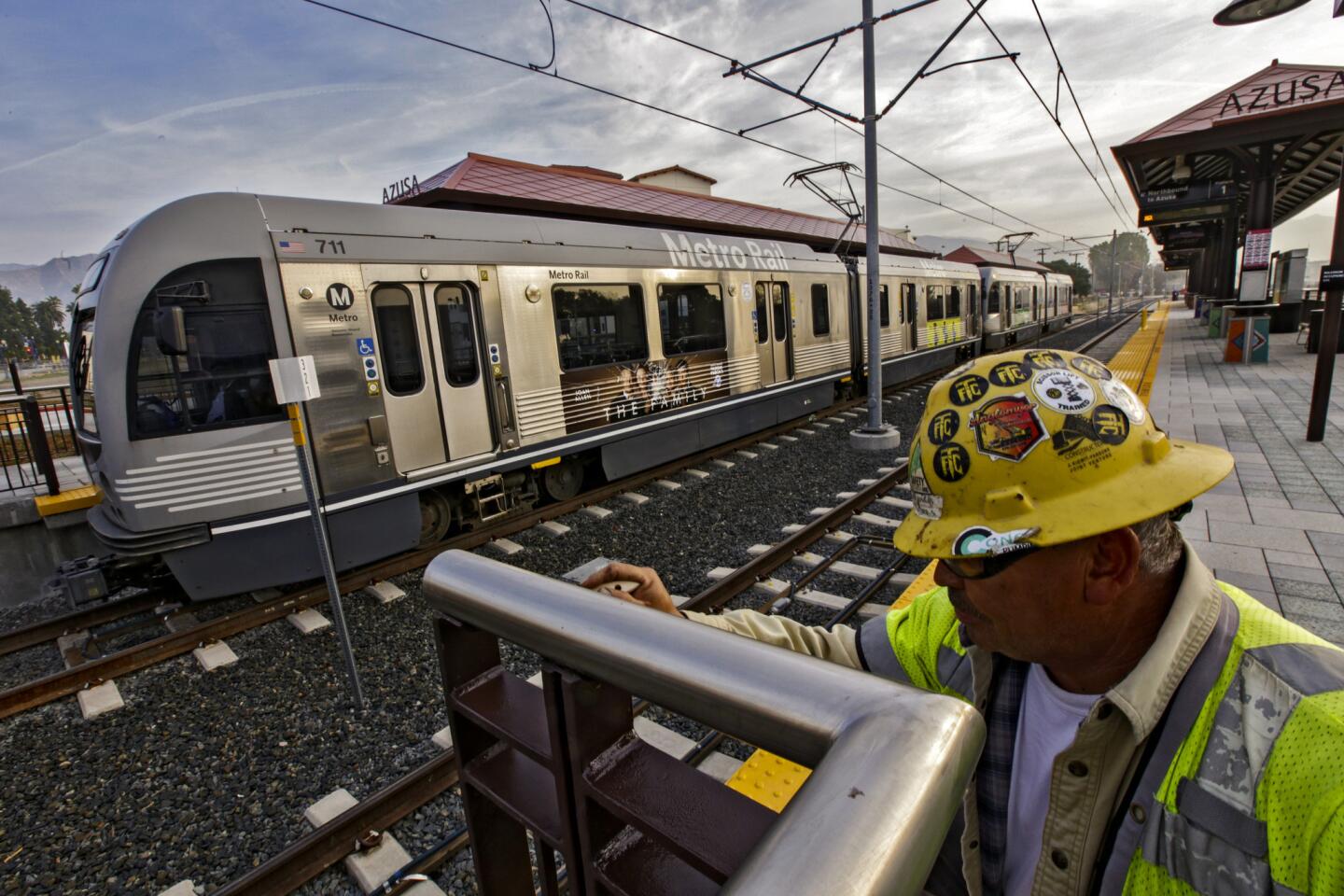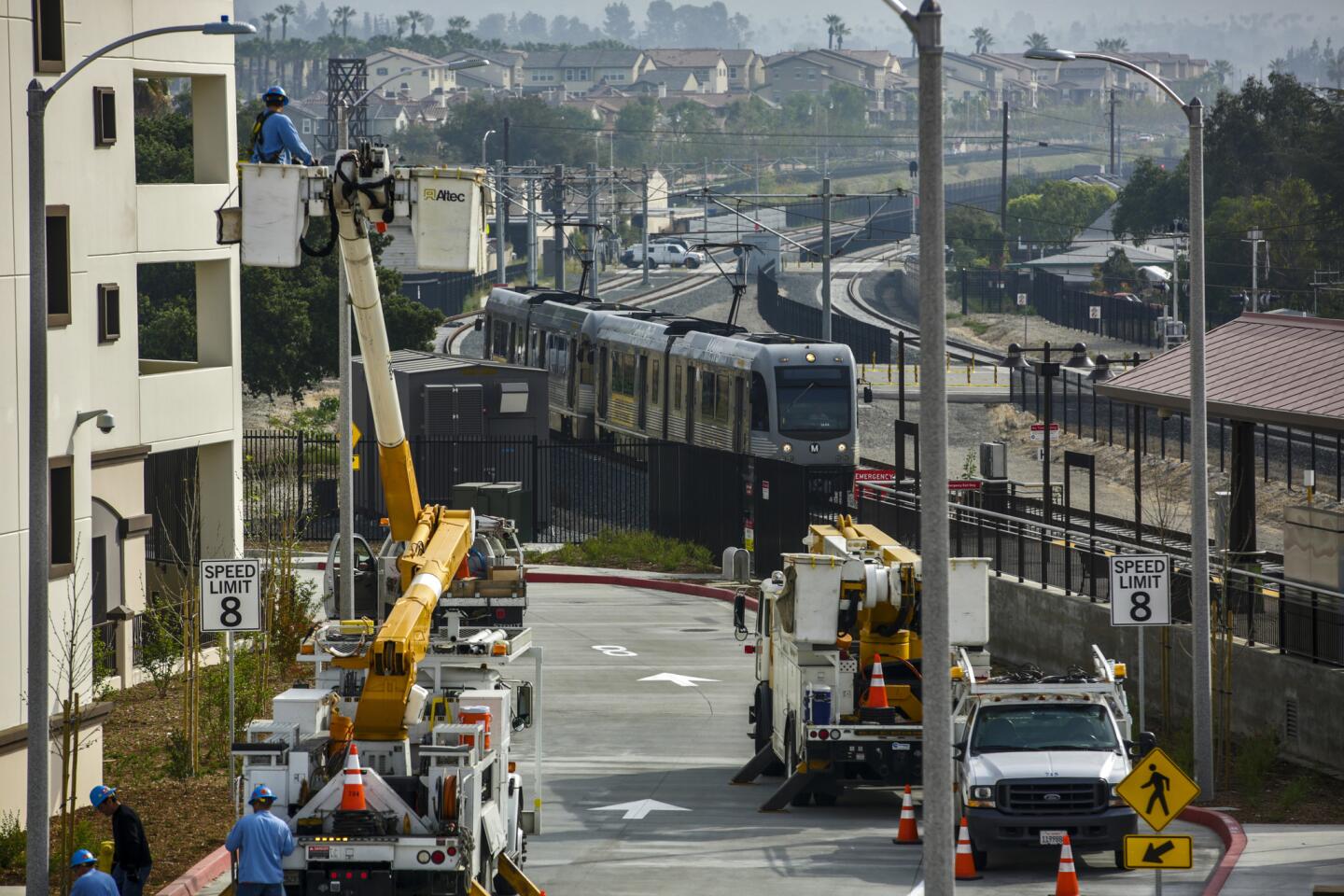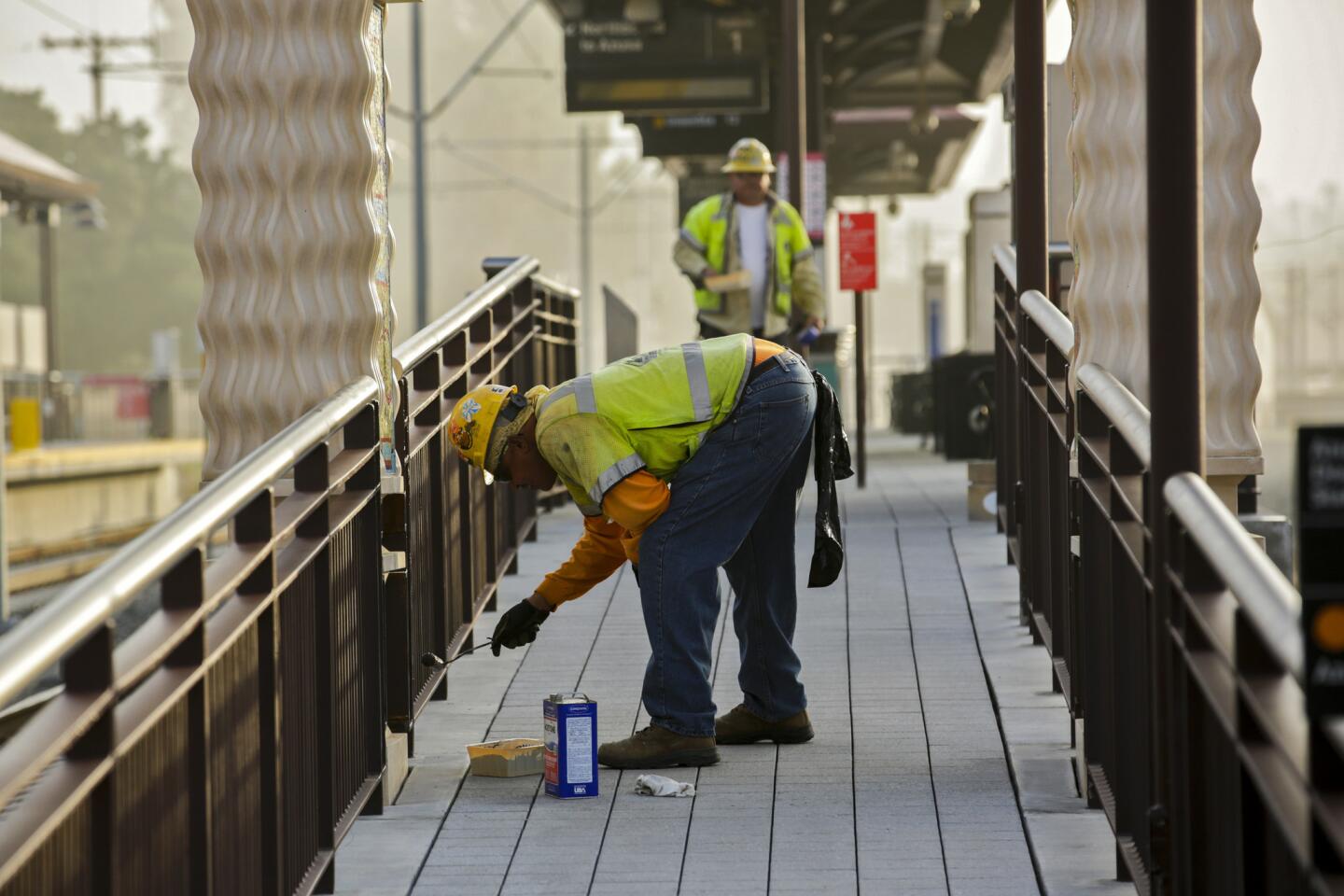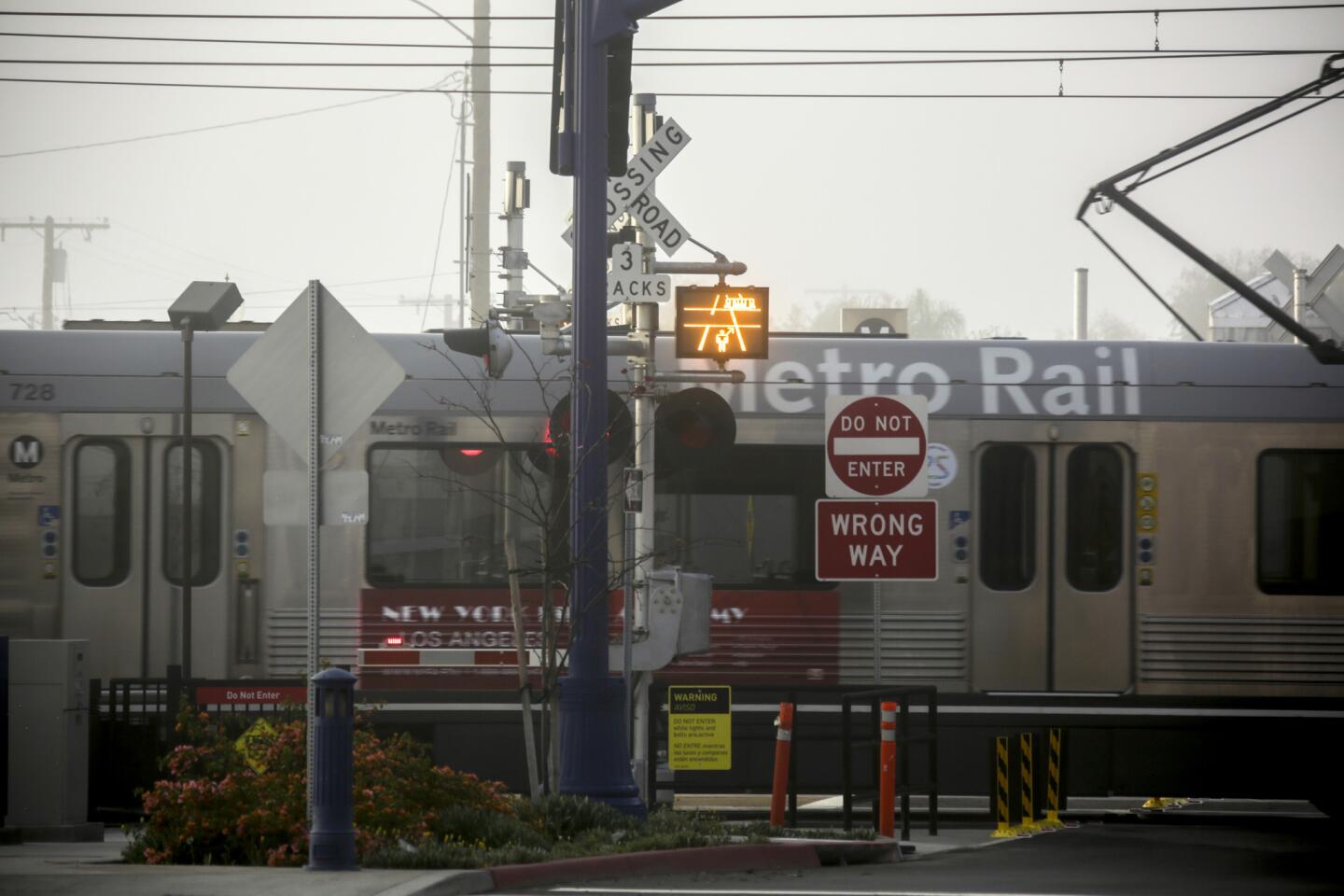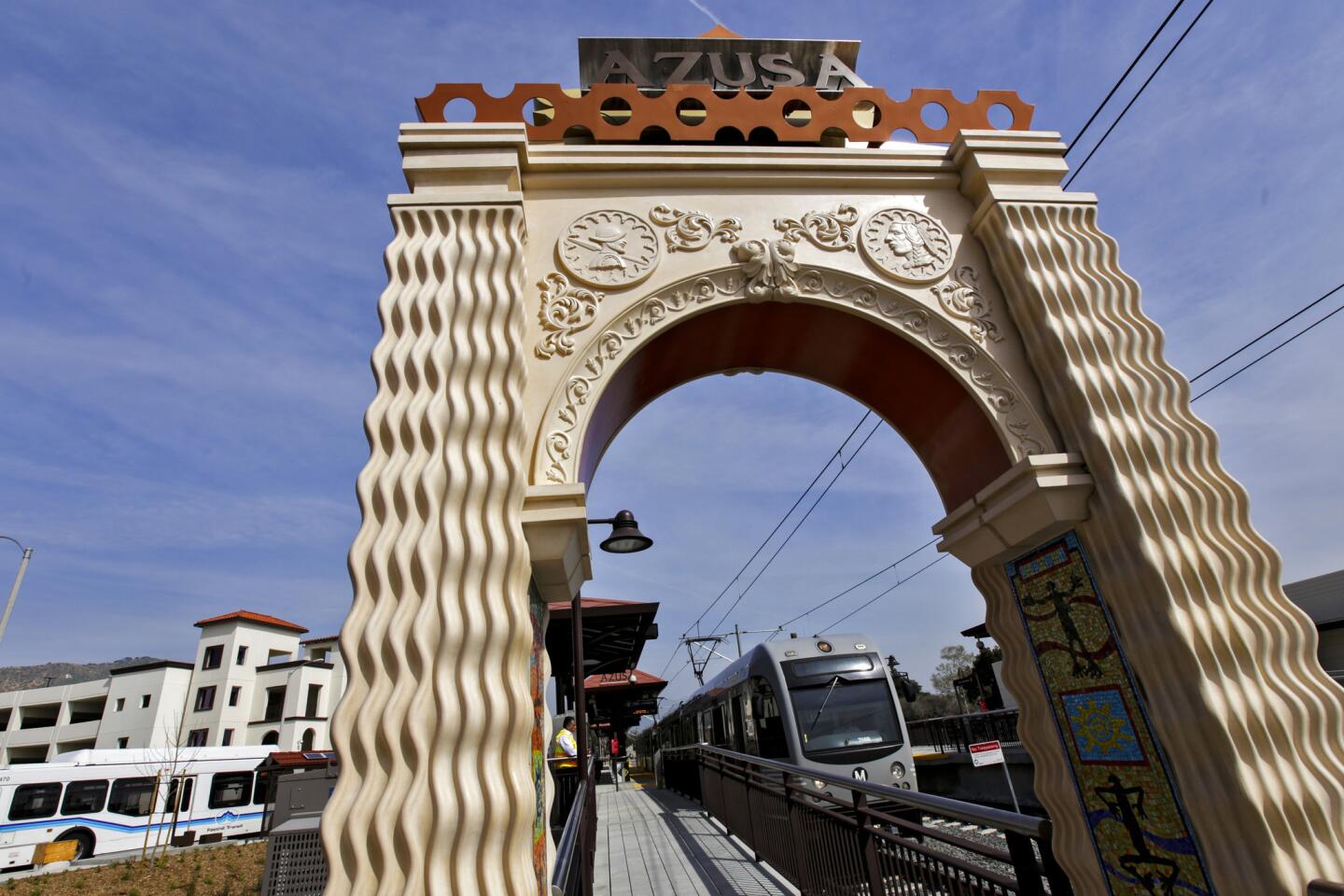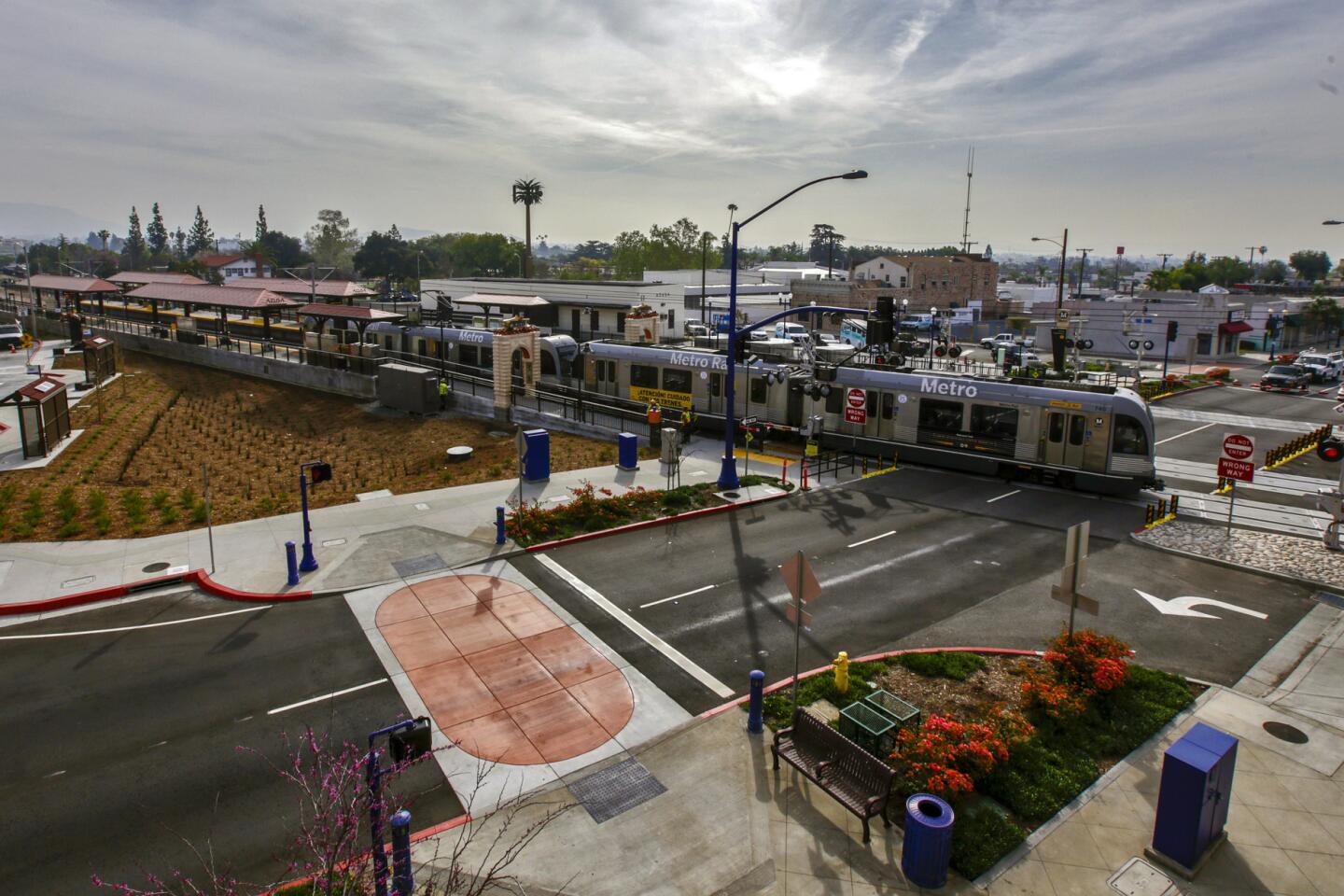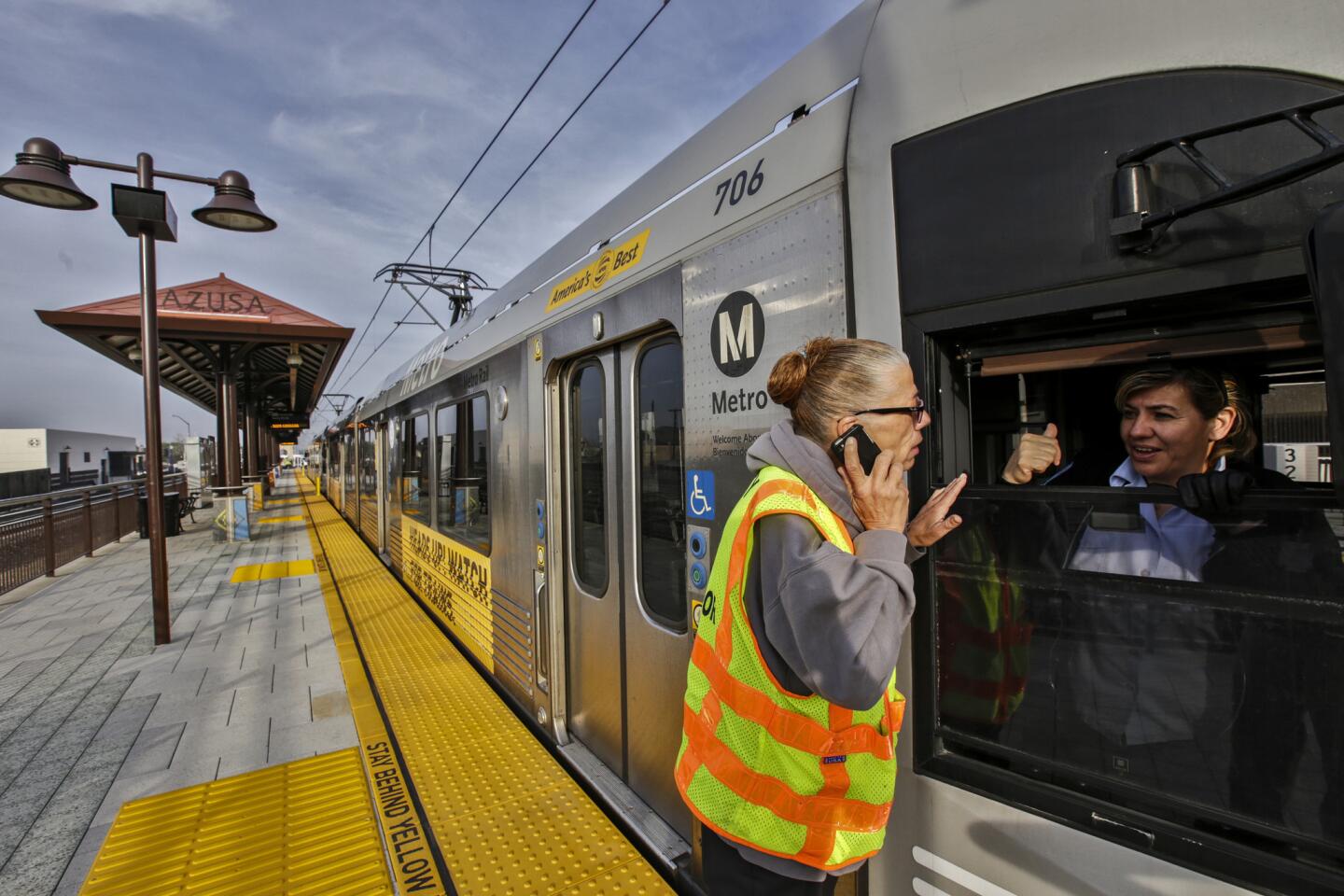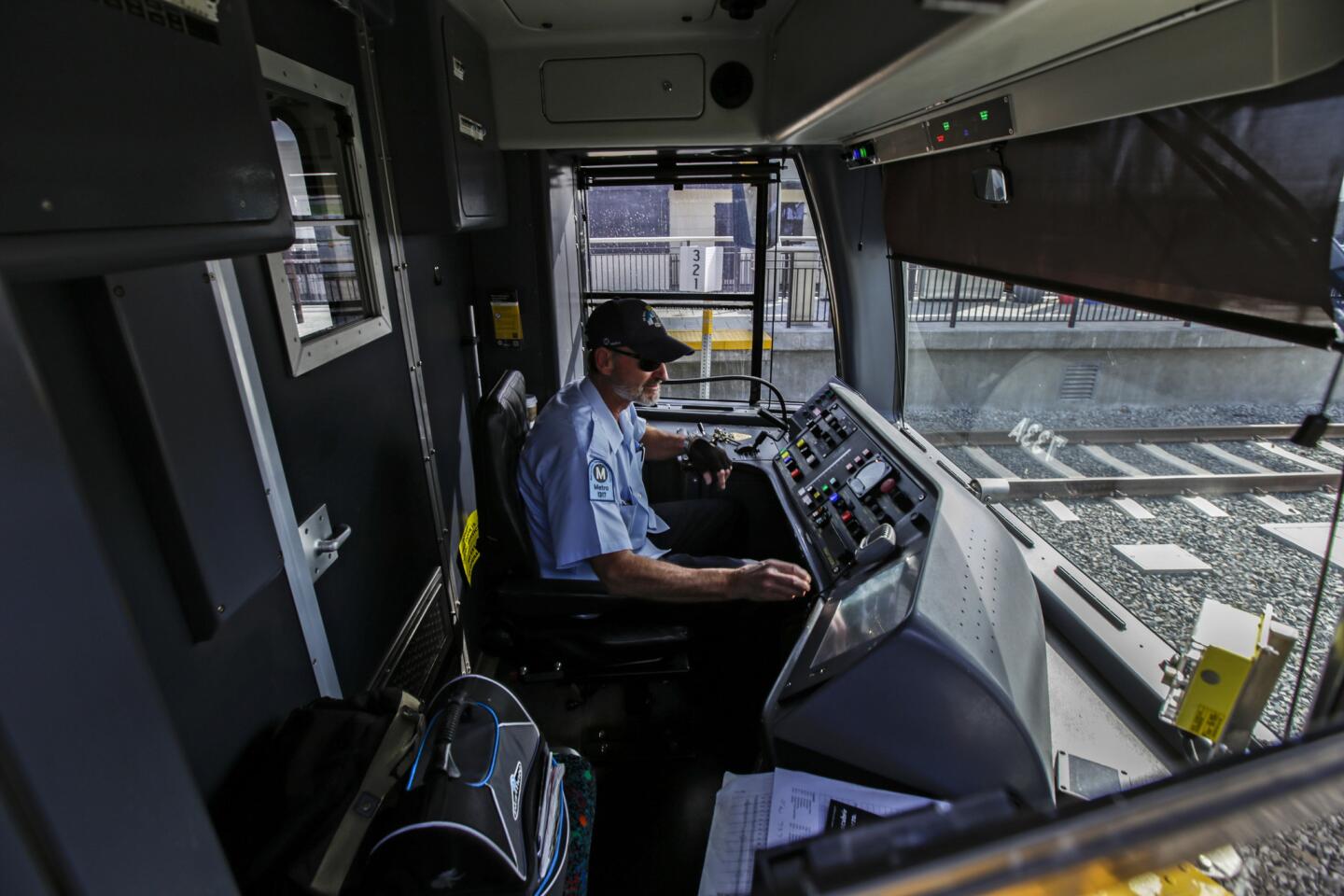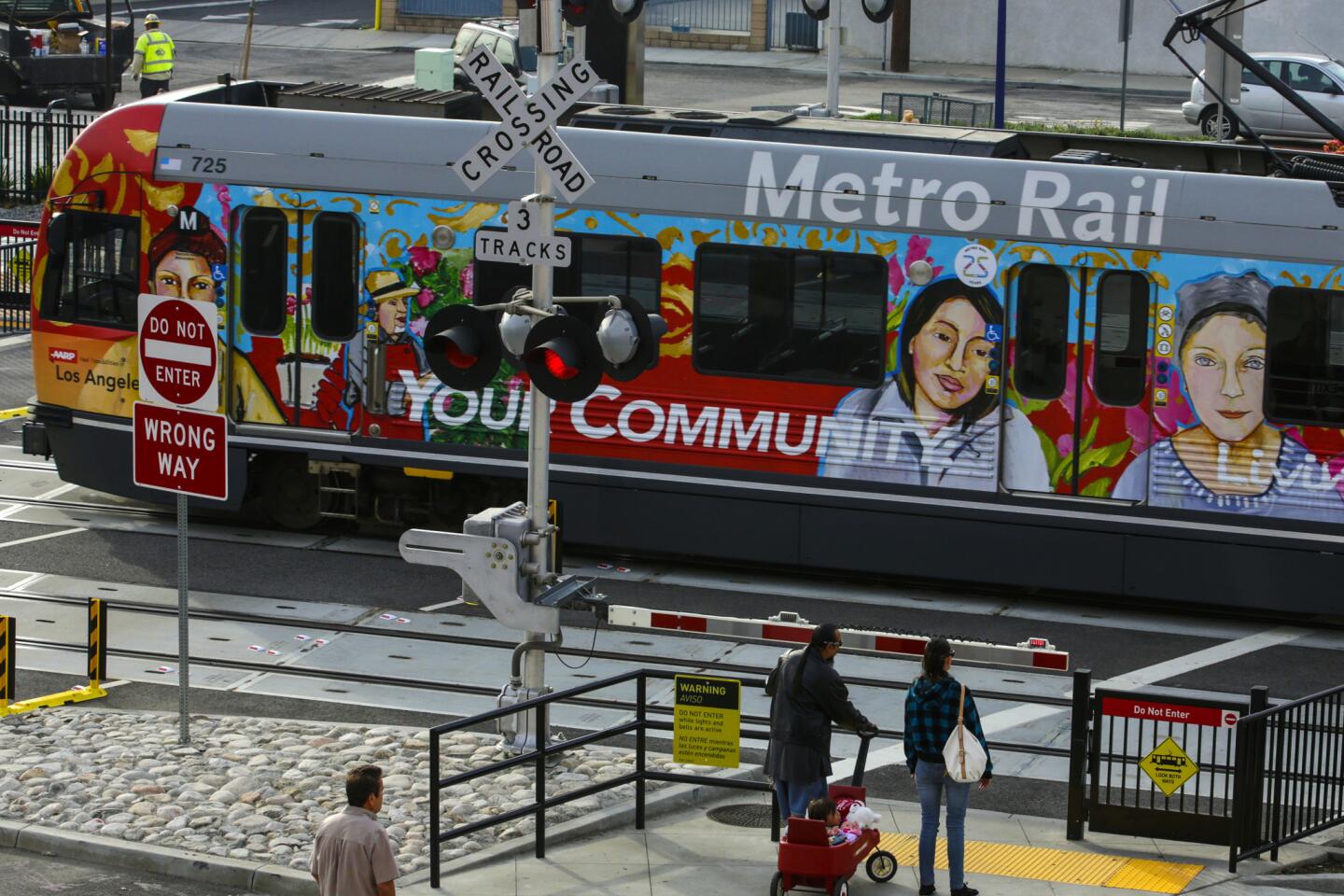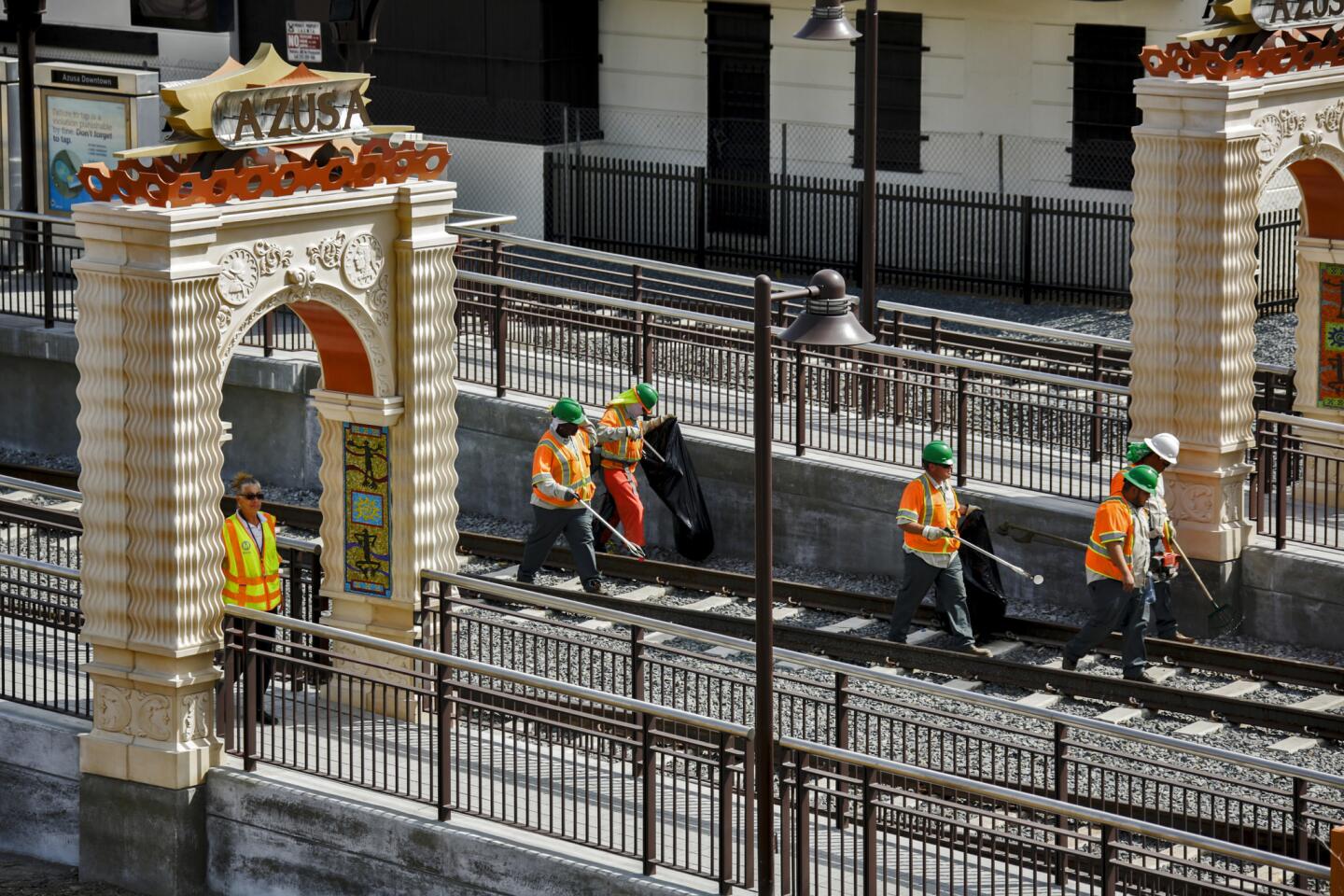Metro Gold Line extension tests San Gabriel Valley’s support for transit
For decades, San Gabriel Valley commuters have groused about bumper-to-bumper traffic on the freeways that connect them to central Los Angeles.
Starting Saturday, there is a new alternative: A 11.5-mile extension of the Metro Gold Line, stretching east from Pasadena through the cities of Arcadia, Monrovia, Duarte, Irwindale and Azusa.
The $1-billion project’s path through quiet bedroom communities represents a new chapter, and new challenges, for the Metropolitan Transportation Authority, which has never brought a rail line so deep into suburbia.
NEWSLETTER: Get essential California headlines delivered daily >>
Supporters say the line will release the region’s pent-up demand for alternative transportation options. The test, critics say, is whether Metro can attract — and retain — regular riders in suburban cities where driving is still the norm.
“Things are so bad on the freeways that folks who otherwise wouldn’t think about it will get on transit,” said Habib Balian, chief executive officer of the Metro Gold Line Foothill Extension Construction Authority. “When they do, they’ll be so impressed by what they see.”
The Foothill Extension is the first new stretch of passenger rail in Los Angeles County in nearly four years, and is the first to be built and opened with funding from Measure R, the half-cent sales tax increase for transportation projects that county voters approved in 2008.
The Gold Line is now the county’s longest light-rail line, stretching 31 miles through Pasadena, Highland Park, downtown Los Angeles and the cultural hubs of Chinatown and Boyle Heights.
From the line’s new terminus in Azusa, the $1.75 one-way ride to Union Station will take 49 minutes. From there, passengers can transfer to Metrolink and Amtrak, continue on the Gold Line to East Los Angeles, or transfer to another Metro rail line.
Trains will run every 12 minutes during rush hour, less frequently during off-peak periods.
In addition to the employment centers of Pasadena and Downtown L.A., the train will connect Southern California’s growing rail network to Santa Anita Park, which is a half-mile from the Arcadia station. The benches on the platform are adorned with Art Deco-style racing scenes.
Chris Harris, 48, of Covina said he plans to go to the races several times a year with his 5-year-old son. “He loves riding the train, and I like going to the track,” Harris said. “It’s a beautiful old place.”
The route has brought some criticism from urbanists and planners who say the string of cities along the route don’t have the population density to support a passenger rail line. Until now, Metro’s rail projects have run through denser neighborhoods with more transit-dependent passengers, including Hollywood, Boyle Heights and Exposition Park.
Metro estimates the Gold Line will have about 66,000 boardings a day by 2035, with about 13,500 of them on the new extension. Supporters say the route will quickly exceed projections.
A decade ago, support for the Foothill Extension was tepid, in part because projected ridership figures were lower than for other projects, including the Wilshire Boulevard subway and a light-rail line to Santa Monica.
But San Gabriel Valley transit boosters pushed back, saying suburban communities deserved rail lines, too. A few threatened to appeal directly to Congress for funds if Metro didn’t back the project.
But Measure R staved off that conflict. The half-cent sales tax proposal needed support from two-thirds of county voters to pass, and the support of the San Gabriel Valley was key.
“What makes these initiatives work is that you spread all the projects around the county,” Balian said. Plus, he said, the Gold Line was “shovel ready,” meaning much of the design and planning work had already been done.
Balian and others, including Los Angeles Mayor Eric Garcetti, are urging another extension of the line through Glendora, San Dimas, La Verne, Pomona, Claremont and Montclair. Some transportation officials have dubbed it the “Brain Train” because it will connect to the Claremont Colleges.
That extension is seen as a favorite for a list of projects that Metro would fund if county voters approve another sales tax increase in November.
See more of our top stories on Facebook >>
The construction authority has received high marks for its project management. Rail construction budgets tend to balloon, but the Foothill Extension’s cost of $690 million grew just 7% to $741 million over the last five years.
Metro contributed an additional $210 million for a 24-acre rail maintenance and operations center in Monrovia, and some cities funded improvements of their own, including a bridge over Santa Anita Avenue.
Agnes Duyshart, 86, and her grandson walked across the Monrovia station’s broad brick plaza on a recent weekday, admiring the band shell and a row of fountains. She drives everywhere, and although she lives two miles from the Arcadia station, she won’t take the train often, she said.
“Once in a while, to Pasadena, or to explore downtown,” Duyshart said. And, she added, she may use it to visit her son, who lives a short walk from the Highland Park station.
Her grandson, Peter Duyshart, 21, of Glendora said he’ll take the train regularly to reach an internship in Hancock Park. Right now, he carpools with his father to Pasadena, boards the Gold Line and transfers to the Purple Line at Union Station.
“It will smooth out my commute,” he said. “I’m a big fan of transit.”
All six stations have parking garages, but there have already been concerns that there won’t be enough parking. The Sierra Madre Villa station in Pasadena, the line’s old terminus, has a 900-space garage that often fills up in the morning.
“I would say there’s not a transit-riding culture here,” said Gary Kovacic, the mayor of Arcadia. But, he said, local governments are adding shuttles and encouraging residents to take a bus, bike or walk, and to leave their cars at home.
The line’s new terminus is adjacent to Azusa Pacific University and Citrus College. Metro hopes to attract students who want to go to Pasadena or downtown and can’t or don’t want to drive.
Although the Great Recession slowed development, officials say empty lots near the stations will eventually be home to hundreds of units of housing and retail space, which will encourage residents to live without a car or to leave theirs at home.
In Monrovia, construction will start soon on a 261-unit apartment complex and food hall next to the station. In Duarte, near the City of Hope cancer treatment center, officials are planning a 250-room hotel and a commercial and residential complex.
And at the end of the line is a planned community called Rosedale, which will eventually contain 1,250 houses within walking distance of the APU/Citrus College station. The homes, targeted at older adults, are one way to draw more residents onto transit, officials say.
Twitter: @laura_nelson
ALSO
L.A. Unified keeps schools open after ‘non-credible’ threat
Lopez: Power grab topples another defender of California’s environment
Officer tried to report knife found on O.J. Simpson’s property years ago, attorney says
More to Read
Sign up for Essential California
The most important California stories and recommendations in your inbox every morning.
You may occasionally receive promotional content from the Los Angeles Times.
